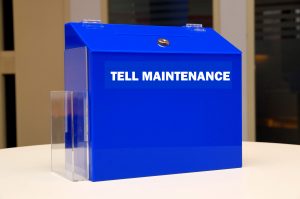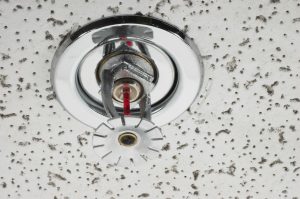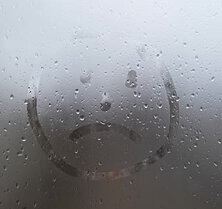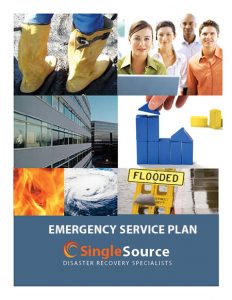Even the most carefully operated commercial building will most likely experience a water damage event sometime in its lifetime. From a minor roof leak to a major flood caused by a pipe break or a malfunctioning sprinkler system, any kind of water intrusion has the ability to significantly impact, and possibly totally interrupt, the daily operations of a busy commercial property. Regularly conducting risk management assessments such as scheduling monthly, quarterly, or annual examinations of roofs, walls, windows, and other building components is essential in reducing the likelihood of water damage—and a possible long-term business interruption.
Listen to Tenants
 Occupant complaints are often indicators of impending building problems. Are there reports of mustiness or a moldy smell in an area? These complaints are often early warning signs of a problem. Consider establishing a “Tell Maintenance” drop box where occupants can easily report concerns to building management and maintenance.
Occupant complaints are often indicators of impending building problems. Are there reports of mustiness or a moldy smell in an area? These complaints are often early warning signs of a problem. Consider establishing a “Tell Maintenance” drop box where occupants can easily report concerns to building management and maintenance.
Check the Roof Every Month
Whether flat or pitched, asphalt or composite, every roof is an at-risk location for unwanted water. Many commercial building roofs are laden with HVAC equipment, vent pipes, skylights and other building system elements, which are all ‘holes’ in the worst possible place — directly overhead. Many roofs are walked on, have tool boxes and test equipment placed on them, catch leaves and branches behind parapets, have sand and abrasives blown over them constantly, or carry billboards or occupant signage. All of these rooftop elements conspire to make this zone especially vulnerable to water intrusion.
- Check all rooftop penetrations regularly from inside and out.
- Are the seals intact around HVAC systems?
- Are the flashings around skylights, stack vents and other rooftop elements in good condition?
- Are roof drains clear and free of debris?
- When inspecting from below, do you see daylight where it shouldn’t be?
- Do you see any water stain marks?
Inspect the Fire Sprinkler System Annually and Protect Against Freezing in Cold Temperatures
 Like any water-based system, sprinkler system pipes are also subject to freezing and corrosion. Corrosion can impact the functionality of the system and even lead to leaks. Freezing water can expand in the pipes, causing them to burst or crack. To help prevent corrosion, it is important to have your sprinkler system pipes inspected and tested annually. Prevent freezing by insulating the pipes during cold winter months.
Like any water-based system, sprinkler system pipes are also subject to freezing and corrosion. Corrosion can impact the functionality of the system and even lead to leaks. Freezing water can expand in the pipes, causing them to burst or crack. To help prevent corrosion, it is important to have your sprinkler system pipes inspected and tested annually. Prevent freezing by insulating the pipes during cold winter months.
Inspect Windows
 Regular inspections of windows should be part of your risk management plan where you ask yourself the following questions:
Regular inspections of windows should be part of your risk management plan where you ask yourself the following questions:
- Are any of the units “fogged” indicating a seal failure?
- Are the weather-stripping elements in place?
- Are the exterior joints and flashing systems in good shape?
Check At-Grade Plumbing Systems Monthly
- Test basement flood control and sump systems.
- Replace any leaking fittings or drains immediately, even if small.
- Does the irrigation system spray water against the foundation wall?
- Are roof drain outlets open and cleared of debris?
- Do downspouts direct water away from the foundation?
- Investigate the source of any standing water.
Schedule Quarterly Below Grade Inspections
Basement walls and floors play crucial roles in protecting the building from water intrusion, and can provide important warnings of water problems above. Also check for signs of effervescence, a condition where moisture boils up through the surface of the concrete, evidenced by flaking of mortar or concrete. A landscape irrigation line leak may first manifest as mold on the basement walls.
- Check basement floor drains and drainage system.
- Check all basement walls for signs of water staining or damage. If found, track the source and repair immediately.
Ensure a rapid response to water damage events
 Building staff should have an emergency response plan. This will help ensure a more rapid recovery from a major roof leak, flooded basement, or soaked office carpets. Often the speed of response to a water damage event is the most vital key to getting back to normal day-to-day operations quickly. Partnering with a trustworthy disaster restoration company, like Single Source, who can safely and effectively extract water, preserve valuable contents, and repair building damage quickly is a must. Single Source offers all commercial clients, at no charge, an Emergency Service Plan that includes an individualized property risk assessment and in-person building walk through. We’ll help you put together a custom, comprehensive emergency plan that will ensure a rapid response to ANY property disaster that may occur to help preserve valuable contents and safeguard structural integrity and, perhaps, most important of all: Ensure the safety of all employees and/or tenants. Interested? Contact us for more information.
Building staff should have an emergency response plan. This will help ensure a more rapid recovery from a major roof leak, flooded basement, or soaked office carpets. Often the speed of response to a water damage event is the most vital key to getting back to normal day-to-day operations quickly. Partnering with a trustworthy disaster restoration company, like Single Source, who can safely and effectively extract water, preserve valuable contents, and repair building damage quickly is a must. Single Source offers all commercial clients, at no charge, an Emergency Service Plan that includes an individualized property risk assessment and in-person building walk through. We’ll help you put together a custom, comprehensive emergency plan that will ensure a rapid response to ANY property disaster that may occur to help preserve valuable contents and safeguard structural integrity and, perhaps, most important of all: Ensure the safety of all employees and/or tenants. Interested? Contact us for more information.
Article Information Sources: Hanover Risk Solutions, Insureon
The post Tips to Prevent Water Damage in Commercial Buildings appeared first on Single Source Disaster Recovery Specialists.

